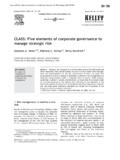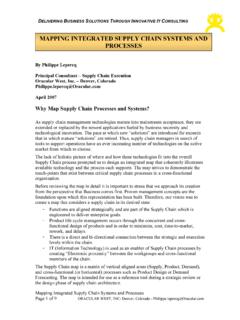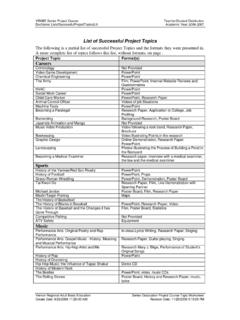Transcription of Blast furnace slag granulation plant technology
1 MILLENNIUM STEEL 201428 Blast furnace slag granulation plant technologyA modern Blast furnace can produce more than 1Mt/yr of slag. Slag granulation using water sprays is now an established technology . It not only simplifies Blast furnace casting floor operations, but also provides an economic route for the production of a valuable raw material for a host of Blast furnace produces large amounts of liquid slag, which can be processed into valuable raw materials for the cement and other industries. For example, in cement production, granulated slag can replace up to 70% of the more costly Portland clinker.
2 The slag volume depends on the quality of the raw materials used in the BF and may range from 200 to 500kg/THM. Typical production levels of a modern Blast furnace are 8,000-12,000 THM/day so the annual slag production could amount to more than processing of Blast furnace slag into a product suitable for further use is accomplished by a slag granulation plant . This paper summarises modern slag granulation plant technologies, which have been successfully demonstrated at industrial plants for more than 20 granulation PLANTThe main objective of the slag granulation plant is processing liquid Blast furnace slag into valuable raw materials for the cement and construction industries.
3 The value of the slag depends on its mineralogical, chemical, physical and mechanical properties, such as basicity, glass content, structure and moisture content. These technical properties are related to the Blast furnace burden and process, the applied granulation technology and operating conditions, storage and dewatering time, etc, and Figure 1 illustrates its : R van Laar, E Dupon, J Barel and M KamerlingDanieli Corus BVr Fig 1 Complex dependency of slag technical propertiesr Fig 2 Schematic of a slag granulation plantRAW MATERIALS AND IRONMAKINGaMILLENNIUM STEEL 201429granulation, but at the last part of the BF cast, when the slag volumes might increase, an additional 900m3/hr can be added by activating additional spray heads and increasing the total flow to 2,400m3/hr.
4 The requirements of the spray head are:` Simple and logical construction to reduce fabrication cost and simplify replacement` Buildup of wear resistant materials, eg, the use of ceramic insets for the nozzles and guides` Easy to inspect and easy to replace` Easy access and easy to this quenching process, water is evaporated and SOx compounds are released. These emissions can be eliminated by the application of a condensing tower that includes an assembly of water spray nozzles. These sprays ensure that emissions are dissolved in the water.
5 They are then partly neutralised by the CaO in the slag. Views of the condensing tower system are shown in Figure entire granulation tank is lined with wear resistant refractory as it is exposed to a highly turbulent and erosive mixture of water and slag sand. This mixture is transferred The slag granulation plant comprises a granulation section, a dewatering section and a storage section, as illustrated in Figure section Here, the liquid Blast furnace slag is water quenched and solidified into small pieces, eliminating the need for heavy crushing equipment.
6 The liquid slag flows by runners from the Blast furnace to the granulation unit. From the runner, the liquid slag stream at around 1,500 C is poured into a high velocity water stream at the granulation spray head before ending up at around 50 C in the granulation tank. This rapid solidification followed by breaking up of the material into small pieces is controlled by the excess of water used. Due to the high temperature of the liquid slag, the water is partly evaporated and subsequently condensed in a condensing tower located above the granulation tank.
7 The production of slag during a Blast furnace tapping normally ranges up to 10t/min. To cope with this variation, the water stream to the granulation unit can be controlled by an energy balance calculation to ensure efficient and economic performance. The control element is a valve, regulating part of the water flow to the granulation spray head. The granulation spray head is the technological heart of the granulator and is where the water and slag are mixed intensively, ensuring fast and efficient granulation (see Figure 3).
8 The spray head is designed to produce a specific flow pattern of water for optimum mixing and is located to direct high-pressure water jets into the free falling molten slag main volume of water is directed by the jets to form a fast moving water trough in the bottom of the granulation chute. The purpose of this water layer, in addition to granulating the slag, is to protect the granulation runner and to carry away the granulated mix. Additionally, a number of jets are positioned on the sides of the slag stream to ensure all slag is granulated into small pieces as quickly as possible, to supply additional cooling, and also to propel the slag/water mix in the chute.
9 The configuration of the water jets is such that the liquid slag will, under normal circumstances, not touch the bottom of the granulation chute. The spray heads contain detachable nozzle plates with ceramic inserts and spray headers that can be replaced quickly during short maintenance water quantities for the spray head are approximately as follows:` Lower bottom spray head 1,200m3/hr` Upper bottom spray head 600m3/hr` Side sprays 100m3/hrUnder normal circumstances, 1,800m3/hr is used for r Fig 3 The granulator spray head and transport chuter Fig 4 Condensing tower and spray nozzlesMILLENNIUM STEEL 201430by gravity to the dewatering section for separation of slag sand and an alternative to wet slag granulation and subsequent dewatering.
10 Dry slag granulation technology has been pursued for many years but has not yet been demonstrated to be economic on an industrial scale as these economics depend strongly on the heat recovery efficiency. It is acknowledged that heat recovery is difficult to justify economically with water granulation systems because of the intermittent nature of the process and the relative low temperature of the water after dewatering. Dewatering section The granulation section adds water to the slag, which must be removed and recycled.




